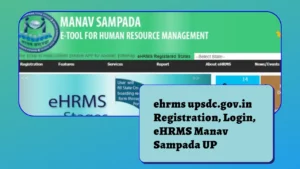Introduction
The eHRMS (Electronic Human Resource Management System) platform, accessible at ehrms.upsdc.gov.in, is a state-of-the-art digital solution implemented by the Government of Uttar Pradesh to streamline and enhance the management of human resources within the state.
This innovative system leverages technology to automate various HR processes, ensuring efficiency, transparency, and accountability in the handling of workforce-related affairs.
Key Features of eHRMS.UPSDC.GOV.IN UP
1. Comprehensive Employee Database
The eHRMS platform maintains an extensive database of all government employees in Uttar Pradesh. It includes vital information such as personal details, professional qualifications, employment history, and contact information. This centralized database serves as a fundamental resource for various HR functions.
2. Leave Management System
eHRMS provides a robust leave management system that allows employees to apply for leaves, view their leave balances, and track the status of their leave requests. This feature ensures a structured and transparent approach to managing employee absences.

3. Performance Evaluation and Appraisal
The platform facilitates the performance evaluation process by enabling supervisors to set objectives, track progress, and conduct appraisals electronically. It ensures a fair and standardized assessment of employee performance, which is crucial for career growth and development.
4. Payroll Management
eHRMS automates the payroll process, ensuring accurate and timely disbursal of salaries and allowances to employees. It calculates deductions, allowances, and tax withholdings based on predefined rules and regulations.
5. Training and Development
Employees can access a range of training programs and resources through eHRMS. The platform tracks participation, monitors progress, and records achievements, contributing to a culture of continuous learning and development.
6. Grievance Redressal
eHRMS offers a platform for employees to raise and track grievances. This feature ensures that concerns are addressed promptly, fostering a conducive work environment.

(FAQs)
Q1. What is eHRMS.UPSDC.GOV.IN UP?
eHRMS.UPSDC.GOV.IN UP is an electronic Human Resource Management System implemented by the Government of Uttar Pradesh to streamline and enhance the management of human resources within the state.
Q2. How can employees access the eHRMS platform?
Employees can access the eHRMS platform by visiting the official website at ehrms.upsdc.gov.in and logging in with their designated credentials.
Q3. Can employees apply for leaves through eHRMS?
Yes, employees can apply for leaves through the platform. The leave management system allows employees to submit leave requests, view leave balances, and track the status of their requests.
Q4. Does eHRMS handle payroll management?
Yes, eHRMS automates the payroll process, ensuring accurate and timely disbursal of salaries and allowances to employees. It calculates deductions, allowances, and tax withholdings based on predefined rules and regulations.
Q5. How does eHRMS contribute to employee development?
eHRMS provides access to a range of training programs and resources. It tracks participation, monitors progress, and records achievements, contributing to a culture of continuous learning and development.
Q6. Is there a grievance redressal mechanism in place?
Yes, eHRMS offers a platform for employees to raise and track grievances. This feature ensures that concerns are addressed promptly, fostering a conducive work environment.
Conclusion
eHRMS.UPSDC.GOV.IN UP stands as a testament to the Government of Uttar Pradesh’s commitment to modernizing and optimizing human resource management. By leveraging technology to automate key HR functions, the platform enhances efficiency,
transparency, and accountability in the management of the state’s workforce. This innovative system not only benefits employees but also contributes to the overall growth and development of Uttar Pradesh. With its array of features and functionalities, eHRMS is set to revolutionize HR practices within the state.